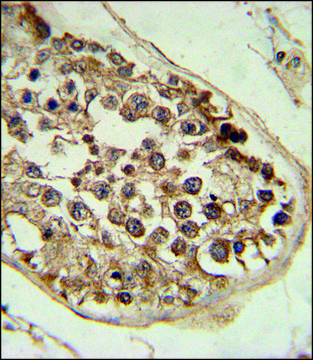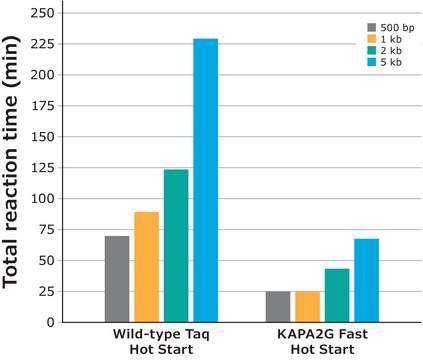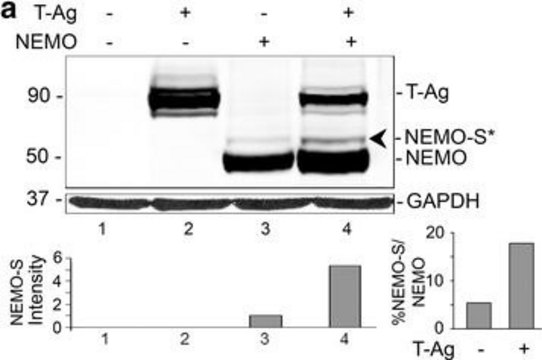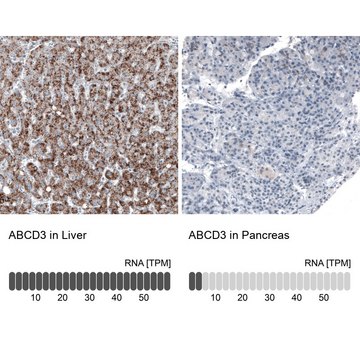Recommended Products
biological source
rabbit
antibody form
serum
antibody product type
primary antibodies
clone
polyclonal
species reactivity
mouse
manufacturer/tradename
Chemicon®
technique(s)
immunohistochemistry: suitable (paraffin)
western blot: suitable
NCBI accession no.
UniProt accession no.
shipped in
wet ice
target post-translational modification
unmodified
Gene Information
human ... BAX(581)
General description
The previously assigned protein identifier Q07814 has been merged into Q07812. Full details can be found on the UniProt database.
Specificity
Recognizes Mouse and Rat Bax-alpha, a 21 kDa protein, as well as a longer 24 kDa. Bax-beta isoform and a 5 kDa Bax-gamma isoform, which are present in much smaller amounts in most tissues. Does not react with other members of the Bcl-2 family, as verified by immunoblot.
Immunogen
A synthetic peptide corresponding to amino acids 43-61 of the mouse Bax-alpha protein.
Application
Immunohistochemistry (ABC method) on formalin-fixed paraffin-embedded sections (1:600-1:1500)
Immunoblot (1;2500) using ECL detection.
High levels of Bax-alpha are found in areas of the brain, including the cerebrum and cerebellum, as well as the small intestine, stomach, overy, testis, uterus, thymus, and spleen.
Optimal working dilutions must be determined by end user.
Immunoblot (1;2500) using ECL detection.
High levels of Bax-alpha are found in areas of the brain, including the cerebrum and cerebellum, as well as the small intestine, stomach, overy, testis, uterus, thymus, and spleen.
Optimal working dilutions must be determined by end user.
Research Category
Apoptosis & Cancer
Apoptosis & Cancer
Research Sub Category
BCL2 & Inhibition
BCL2 & Inhibition
This Anti-Bax Antibody is validated for use in WB, IH(P) for the detection of Bax.
Linkage
Replaces: 04-434
Physical form
Liquid antiserum, no preservatives.
Storage and Stability
Store at -20°C for up to 12 months in undiluted aliquots. Avoid repeated freeze-thaw cycles.
Legal Information
CHEMICON is a registered trademark of Merck KGaA, Darmstadt, Germany
Disclaimer
Unless otherwise stated in our catalog or other company documentation accompanying the product(s), our products are intended for research use only and are not to be used for any other purpose, which includes but is not limited to, unauthorized commercial uses, in vitro diagnostic uses, ex vivo or in vivo therapeutic uses or any type of consumption or application to humans or animals.
Not finding the right product?
Try our Product Selector Tool.
Storage Class Code
10 - Combustible liquids
WGK
WGK 1
Flash Point(F)
Not applicable
Flash Point(C)
Not applicable
Certificates of Analysis (COA)
Search for Certificates of Analysis (COA) by entering the products Lot/Batch Number. Lot and Batch Numbers can be found on a product’s label following the words ‘Lot’ or ‘Batch’.
Already Own This Product?
Find documentation for the products that you have recently purchased in the Document Library.
Mohammad Ali Maadi et al.
Andrologia, 54(3), e14349-e14349 (2021-12-10)
Testicular torsion (TT) is an emergency complication that leads to oxidative stress and adversely affects spermatogenesis. Although immediate treatment consists of testicular detorsion (TD) to reverse TT-induced ischemia, mechanisms underlying recovery have yet to be fully understood. The current study
Malekzadeh Yasin et al.
Environmental toxicology, 33(11), 1204-1213 (2018-08-21)
The present experimental study was carried out to investigate the crosslink between aflatoxin B1 (AFB1)-induced oxidative stress and mitochondria-dependent apoptosis in testicles. For this purpose, 24 mature male Swiss albino mice were randomly divided into control and test groups. The
Hojat Anbara et al.
Environmental toxicology, 36(2), 223-237 (2020-09-21)
Aspartame is one of the most common consumed artificial sweeteners utilized in many food products and beverages. It has been indicated that long-term consumption of aspartame leads to reproductive toxicity but its mechanism is not well-clear. In this study we
Barkha P Patel et al.
PloS one, 5(2), e9386-e9386 (2010-03-03)
Caloric restriction (CR) extends lifespan through a reduction in oxidative stress, delays the onset of morbidity and prolongs lifespan. We previously reported that long-term CR hastened clinical onset, disease progression and shortened lifespan, while transiently improving motor performance in G93A
Xiao Fang et al.
International journal of oncology, 51(2), 525-532 (2017-06-20)
Telomerase-targeted treatments for cancer have received a great deal of attention because telomerase is detected in nearly all cancer cells but is not expressed in most normal tissues. Aneuploidy refers to a chromosome number that is not a multiple of
Our team of scientists has experience in all areas of research including Life Science, Material Science, Chemical Synthesis, Chromatography, Analytical and many others.
Contact Technical Service







